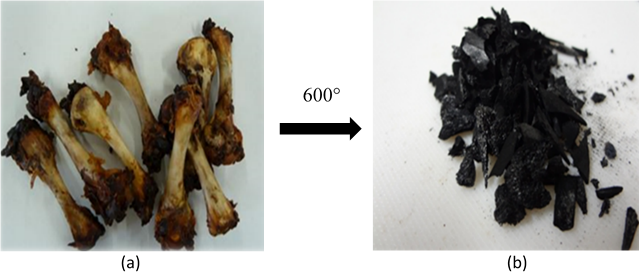Groundwater treatment using CBC Filter to Overcome CKDu Issue
By Eng. B.M.J.K. Balasooriya, Dr. G.G.T. Chaminda, Dr. Champika Ellawala KankanamgeDr. S.K. Weragoda and Prof. Tomonori Kawakami
Chicken Bone Charcoal (CBC) (Figure 1) is one of the best adsorbent which can be used for groundwater treatment in dry zone areas in Sri Lanka. Contamination of groundwater by fluoride, hardness and heavy metals greatly compromise water quality and are severely affecting thousands of people leading health issues including kidney diseases. In Sri Lanka, 12 out of 25 districts exceed the WHO standard for fluoride (1.5 mg/L) while 15 districts exceed SLS standard (1.0 mg/L). Nineteen districts out of 25 exceed the WHO standard and SLS for hardness in drinking water (250 mg/L a CaCO3) ( (Kawakami, et al., 2014).

Figure 1 Preparation of Chicken Bone Charcoal; (a) Original Chicken bones (b) Chicken bone charcoal
Chronic Kidney Disease (CKDu) has gained much attention in recent years since this disease primarily common in the north-central region has been identified to be spreading across the country towards the south. As per the literature, it was clear that fluoride affects to the CKDu and hardness also having a possibility to present in contaminated water at the same time. Few literatures only mentioned about possibility of presence of heavy metal for CKDu. Fluoride and hardness distributions are as follows and parametric values were selected based on the distributions (See figure 2).

Figure 2 Fluoride and Hardness distribution of Sri Lanka (Modified from (Kawakami, et al., 2014)
Anuradhapura, Moneragala, Puttalam, Hambantota and Kurunegala districts show higher fluoride concentrations compared to other areas. Hardness concentrations are higher in Anuradhapura, Vavuniya, Jaffna, Hambantota and Moneragala districts (figure 2). However, heavy metals were not significant in groundwater in Sri Lanka ( (Kawakami, et al., 2014). Extreme conditions of cadmium and lead distributions are displayed only in few locations. The impact of the heavy metal is considerably higher than the other parameters since their availability is in small concentrations.
A Filter was made of 55mm diameter, 850mm high PVC pipe. The filter media was CBC and 2.5kg of 5-25mm size range CBC was packed without compacting (figure 3). Analysis was conducted in three cycles to simulate the different areas considering the distributions in figure 2. As per Kawakami, et al. (2014), fluoride concentration in groundwater varies from 0.0 to 7.0 mg/L. Therefore, 3.0 mg/L avarage was selected for the first cycle. Since, fluoride concentrations >3.0 mg/L has been recorded in 7 districts, it was increased upto 5.0 mg/L in next two cycles with high concentrations of Magnesium and Calcium hardness (Figure 2). Lead and Cadmium concentrations were added only to the third cycle in maximum concentrations as in SLS. Outlet concentration was specified not to exceed 1.0 mg/l, which is the potable water quality standard for Sri Lanka (SLS, 2013).
Purifying of 8150 L is possible by using 2.5kg of CBC with an 8.91mg/g of adsorption capacity in first cycle. It is reduced with the presence of Hardness and Heavy metals in next two cycles. Hardness removal is obtained as 50% even at the end of the cycle while removal efficiency of Lead and Cadmium also reported as >50%.

Figure 3 CBC Filter (a) Schematic Diagram and (b) Field scale filter
Based on analysis results, the practical application of this proposed filter can be categorized under three zones and are shown in figure 4.
Zone 1: If the filter is used in areas having high fluoride concentration, but low hardness concentrations like Nochchiyagama, Nawagattegama, Anamaduwa, Horowpothana, Welikanda, Oddomawadi, Padiyathalawa, Uhana, 2.5kg CBC filter can be used for 3 years for a family having 5 members for their drinking and cooking water requirement.
Zone 2: If the filter is used in area having high fluoride and high hardness concentrations like Medawachchiya, Rabewa, Mihintale, Nuwaragam Palatha, Thalawa, Rajanganaya, Anuradhapura, Kobeigane, Bingiriya, Panduwasnuwara, Wariyapola, Weligepola, Opanayake, Balangoda, Godakawela, Kinniya, Muttur, Badalkumbura, Moneragala, Thanamalwila, Wellawaya, Katharagama, Buttala, it can be used for more than 5 months for a family.
Zone 3: If this filter is used in districts such as Jaffna, Trincomalee, Vavuniya, Mannar or areas like Ambalantota, Embilipitiya, Puttalam, Kalpitiya, Lankapura, Thamankaduwa, Kantale which are high in hardness, but low in fluoride and removing total hardness up to 180mg/L as ?CaCO?_3 is sufficient, CBC filter can be used for more than 6 months for a family.

Figure 4: Potential usage of CBC filter in different Zones in Sri Lanka
References
Kawakami, T. et al., 2014. Groundwater Quality Atlas of Sri lanka. Peredeniya: s.n.
Sri Lanka Standards for potable water - SLS 614: 2013. Drinking Water Standards.
Eng. B.M.J.K. Balasooriya, Dr. G.G.T. Chaminda, Dr. Champika Ellawala Kankanamge
Department of Civil and Environmental Engineering, Faculty of Engineering, University of Ruhuna, Hapugala, Galle, SRI LANKA
Dr. S.K. Weragoda
National Water Supply and Drainage Board, SRI LANKA
Prof. Tomonori Kawakami
Department of Environmental Engineering, Toyama Prefectural University, JAPAN
 Eng. B.M.J.K. Balasooriya
Eng. B.M.J.K. Balasooriya
Colombo Municipal Council
Town Hall,
Colombo 07.
(+94)713940464
kalpanabalasooria1990@gmail.com
Article Forwarded by the Women Engineers' Forum of IESL
